The Relationship Between Urban Perceptions and Bike-Sharing Equity in 15-Minute Metro Station Catchments: A Shenzhen Case Study
Abstract
1. Introduction
2. Study Area and Data
2.1. Study Area
2.2. Data Source
3. Methods
3.1. Equity Analysis
3.2. Streetview Image Processing and Urban Perception Scoring
3.3. Correlation Analysis and Random Forest Regression
4. Findings
4.1. Spatial Inequality of Bikeshare Usage Across Station Catchments
4.2. Spatial Distribution of Urban Perception Scores
5. Discussion
5.1. Inequitable Bikeshare Usages in Metro Lines (Workday vs. Weekend, Morning Peak vs. Evening Peak)
5.2. Urban Perception and Usage Inequality: Correlation Insights
5.3. Modeling Outputs of the Perception Influences
5.4. Implications for Equitable Shared Mobility
6. Conclusions
Author Contributions
Funding
Data Availability Statement
Conflicts of Interest
References
- Jin, S.T.; Sui, D.Z. Bikesharing and Equity: A Nationwide Study of Bikesharing Accessibility in the U.S. Transp. Res. Part A Policy Pract. 2024, 181, 103983. [Google Scholar] [CrossRef]
- Wang, B.; Guo, Y.; Chen, F.; Tang, F. The Impact of the Social-Built Environment on the Inequity of Bike-Sharing Use: A Case Study of Divvy System in Chicago. Travel Behav. Soc. 2024, 37, 100873. [Google Scholar] [CrossRef]
- Brown, A.; Manville, M.; Weber, A. Can Mobility on Demand Bridge the First-Last Mile Transit Gap? Equity Implications of Los Angeles’ Pilot Program. Transp. Res. Interdiscip. Perspect. 2021, 10, 100396. [Google Scholar] [CrossRef]
- McKane, R.G.; Hess, D. The Impact of Ridesourcing on Equity and Sustainability in North American Cities: A Systematic Review of the Literature. Cities 2023, 133, 104122. [Google Scholar] [CrossRef]
- Shaheen, S.; Cohen, A. Shared Ride Services in North America: Definitions, Impacts, and the Future of Pooling. Transp. Rev. 2019, 39, 427–442. [Google Scholar] [CrossRef]
- Duran, A.C.; Anaya-Boig, E.; Shake, J.D.; Garcia, L.M.T.; Rezende, L.F.M.D.; Hérick De Sá, T. Bicycle-Sharing System Socio-Spatial Inequalities in Brazil. J. Transp. Health 2018, 8, 262–270. [Google Scholar] [CrossRef]
- Fishman, E.; Washington, S.; Haworth, N. Bike Share’s Impact on Car Use: Evidence from the United States, Great Britain, and Australia. Transp. Res. Part D Transp. Environ. 2014, 31, 13–20. [Google Scholar] [CrossRef]
- Meredith-Karam, P.; Kong, H.; Stewart, A.; Zhao, J. Understanding and Comparing the Public Transit and Ride-Hailing Ridership Change in Chicago during COVID-19 via Statistical and Survey Approaches. Travel Behav. Soc. 2024, 37, 100838. [Google Scholar] [CrossRef]
- Ewing, R.; Cervero, R. Travel and the Built Environment: A Meta-Analysis. J. Am. Plan. Assoc. 2010, 76, 265–294. [Google Scholar] [CrossRef]
- Jiao, J.; Wang, F. Shared Mobility and Transit-Dependent Population: A New Equity Opportunity or Issue? Int. J. Sustain. Transp. 2021, 15, 294–305. [Google Scholar] [CrossRef]
- Zhou, Z.; Schwanen, T. Exploring the Production of Spatial Inequality in Dockless Bicycle Sharing in Shenzhen. J. Transp. Geogr. 2024, 119, 103955. [Google Scholar] [CrossRef]
- Fan, Y.; Wang, Y.; Yu, Y.; Liang, J. Shenzhen’s 15-Minute City Initiative: A Model for High-Quality Urban Development. Transp. Res. Part A Policy Pract. 2025, 199, 104547. [Google Scholar] [CrossRef]
- Li, Y.; Li, J.; Yu, Z.; Li, S.; Li, A. Exploring the Relationship between the Built Environment and Bike-Sharing Usage as a Feeder Mode across Different Metro Station Types in Shenzhen. Land 2025, 14, 1291. [Google Scholar] [CrossRef]
- Peng, C. Sustainable Urban Development in the Post-Pandemic Era: Smart Shenzhen Based on the 15-Minute City Concept. HSET 2024, 86, 139–145. [Google Scholar] [CrossRef]
- Liu, D.; Kwan, M.-P.; Wang, J. Developing the 15-Minute City: A Comprehensive Assessment of the Status in Hong Kong. Travel Behav. Soc. 2024, 34, 100666. [Google Scholar] [CrossRef]
- Moreno, C.; Allam, Z.; Chabaud, D.; Gall, C.; Pratlong, F. Introducing the “15-Minute City”: Sustainability, Resilience and Place Identity in Future Post-Pandemic Cities. Smart Cities 2021, 4, 93–111. [Google Scholar] [CrossRef]
- Chen, Y.; Yang, X.; Li, X.; Yang, L.; Cheng, S.; Tang, G.; Biljecki, F. Vertical 15-Minute City: Modeling Urban Density and Functional Mix with Multi-Source Geospatial Data. Cities 2026, 169, 106516. [Google Scholar] [CrossRef]
- Hamidi, Z.; Camporeale, R.; Caggiani, L. Inequalities in Access to Bike-and-Ride Opportunities: Findings for the City of Malmö. Transp. Res. Part A Policy Pract. 2019, 130, 673–688. [Google Scholar] [CrossRef]
- Tang, F.; Zeng, P.; Wang, L.; Zhang, L.; Xu, W. Urban Perception Evaluation and Street Refinement Governance Supported by Street View Visual Elements Analysis. Remote Sens. 2024, 16, 3661. [Google Scholar] [CrossRef]
- Guo, Y.; Wang, L.; Tang, F.; Xuan, H.; Chi, B. Commercial Gentrification of Metro Catchment: Lenses of Subjective Perception and Objective Nighttime Light. Res. Transp. Bus. Manag. 2025, 59, 101310. [Google Scholar] [CrossRef]
- Lei, Y.; Zhou, H.; Xue, L.; Yuan, L.; Liu, Y.; Wang, M.; Wang, C. Evaluating and Comparing Human Perceptions of Streets in Two Megacities by Integrating Street-View Images, Deep Learning, and Space Syntax. Buildings 2024, 14, 1847. [Google Scholar] [CrossRef]
- Wang, L.; Han, X.; He, J.; Jung, T. Measuring Residents’ Perceptions of City Streets to Inform Better Street Planning through Deep Learning and Space Syntax. ISPRS J. Photogramm. Remote Sens. 2022, 190, 215–230. [Google Scholar] [CrossRef]
- Wang, X.; Xue, R.; Lu, M.; Wu, J. Riders under the Heat: Exploring the Impact of Extreme Heat on the Integration of Bike-Sharing and Public Transportation in Shenzhen, China. ISPRS Int. J. Geo-Inf. 2024, 13, 438. [Google Scholar] [CrossRef]
- Liu, J.; Chau, K.W.; Bao, Z. Multiscale Spatial Analysis of Metro Usage and Its Determinants for Sustainable Urban Development in Shenzhen, China. Tunn. Undergr. Space Technol. 2023, 133, 104912. [Google Scholar] [CrossRef]
- Chen, Z.; Guo, Y.; Stuart, A.L.; Zhang, Y.; Li, X. Exploring the Equity Performance of Bike-Sharing Systems with Disaggregated Data: A Story of Southern Tampa. Transp. Res. Part A Policy Pract. 2019, 130, 529–545. [Google Scholar] [CrossRef]
- Hosford, K.; Winters, M. Who Are Public Bicycle Share Programs Serving? An Evaluation of the Equity of Spatial Access to Bicycle Share Service Areas in Canadian Cities. Transp. Res. Rec. 2018, 2672, 42–50. [Google Scholar] [CrossRef]
- Jang, S.; An, Y.; Yi, C.; Lee, S. Assessing the Spatial Equity of Seoul’s Public Transportation Using the Gini Coefficient Based on Its Accessibility. Int. J. Urban Sci. 2017, 21, 91–107. [Google Scholar] [CrossRef]
- Chen, L.-C.; Zhu, Y.; Papandreou, G.; Schroff, F.; Adam, H. Encoder-Decoder with Atrous Separable Convolution for Semantic Image Segmentation. In Computer Vision—ECCV 2018; Ferrari, V., Hebert, M., Sminchisescu, C., Weiss, Y., Eds.; Lecture Notes in Computer Science; Springer International Publishing: Cham, Switzerland, 2018; Volume 11211, pp. 833–851. ISBN 978-3-030-01233-5. [Google Scholar]
- Simonyan, K.; Zisserman, A. Very Deep Convolutional Networks for Large-Scale Image Recognition. arXiv 2015, arXiv:1409.1556. [Google Scholar] [CrossRef]
- Duan, J.; Zhao, Z.; Xu, Y.; You, X.; Yang, F.; Chen, G. Spatial Distribution Characteristics and Driving Factors of Little Giant Enterprises in China’s Megacity Clusters Based on Random Forest and MGWR. Land 2024, 13, 1105. [Google Scholar] [CrossRef]
- de Chardon, C.M. The Contradictions of Bike-Share Benefits, Purposes and Outcomes. Transp. Res. Part A Policy Pract. 2019, 121, 401–419. [Google Scholar] [CrossRef]
- Stanley, J.K.; Hensher, D.A.; Stanley, J.R. Place-Based Disadvantage, Social Exclusion and the Value of Mobility. Transp. Res. Part A Policy Pract. 2022, 160, 101–113. [Google Scholar] [CrossRef]
- Duran-Rodas, D.; Wright, B.; Pereira, F.C.; Wulfhorst, G. Demand And/oR Equity (DARE) Method for Planning Bike-Sharing. Transp. Res. Part D Transp. Environ. 2021, 97, 102914. [Google Scholar] [CrossRef]
- Bollenbach, L.; Kanning, M.; Niermann, C. Qualitative Exploration of Determinants of Active Mobility and Social Participation in Urban Neighborhoods: Individual Perceptions over Objective Factors? Arch Public Health 2024, 82, 183. [Google Scholar] [CrossRef] [PubMed]
- Guo, Y.; Yang, L.; Chen, Y. Bike Share Usage and the Built Environment: A Review. Front. Public Health 2022, 10, 848169. [Google Scholar] [CrossRef]
- Guo, Y.; He, S.Y. Perceived Built Environment and Dockless Bikeshare as a Feeder Mode of Metro. Transp. Res. Part D Transp. Environ. 2021, 92, 102693. [Google Scholar] [CrossRef]
- Su, L.; Yan, X.; Zhao, X. Spatial Equity of Micromobility Systems: A Comparison of Shared E-Scooters and Docked Bikeshare in Washington DC. Transp. Policy 2024, 145, 25–36. [Google Scholar] [CrossRef]
- Qian, X.; Niemeier, D. High Impact Prioritization of Bikeshare Program Investment to Improve Disadvantaged Communities’ Access to Jobs and Essential Services. J. Transp. Geogr. 2019, 76, 52–70. [Google Scholar] [CrossRef]
- Dong, L.; Jiang, H.; Li, W.; Qiu, B.; Wang, H.; Qiu, W. Assessing Impacts of Objective Features and Subjective Perceptions of Street Environment on Running Amount: A Case Study of Boston. Landsc. Urban Plan. 2023, 235, 104756. [Google Scholar] [CrossRef]
- Hosseinzadeh, A.; Karimpour, A.; Kluger, R. Factors Influencing Shared Micromobility Services: An Analysis of e-Scooters and Bikeshare. Transp. Res. Part D Transp. Environ. 2021, 100, 103047. [Google Scholar] [CrossRef]
- Qian, X.; Jaller, M.; Niemeier, D. Enhancing Equitable Service Level: Which Can Address Better, Dockless or Dock-Based Bikeshare Systems? J. Transp. Geogr. 2020, 86, 102784. [Google Scholar] [CrossRef]
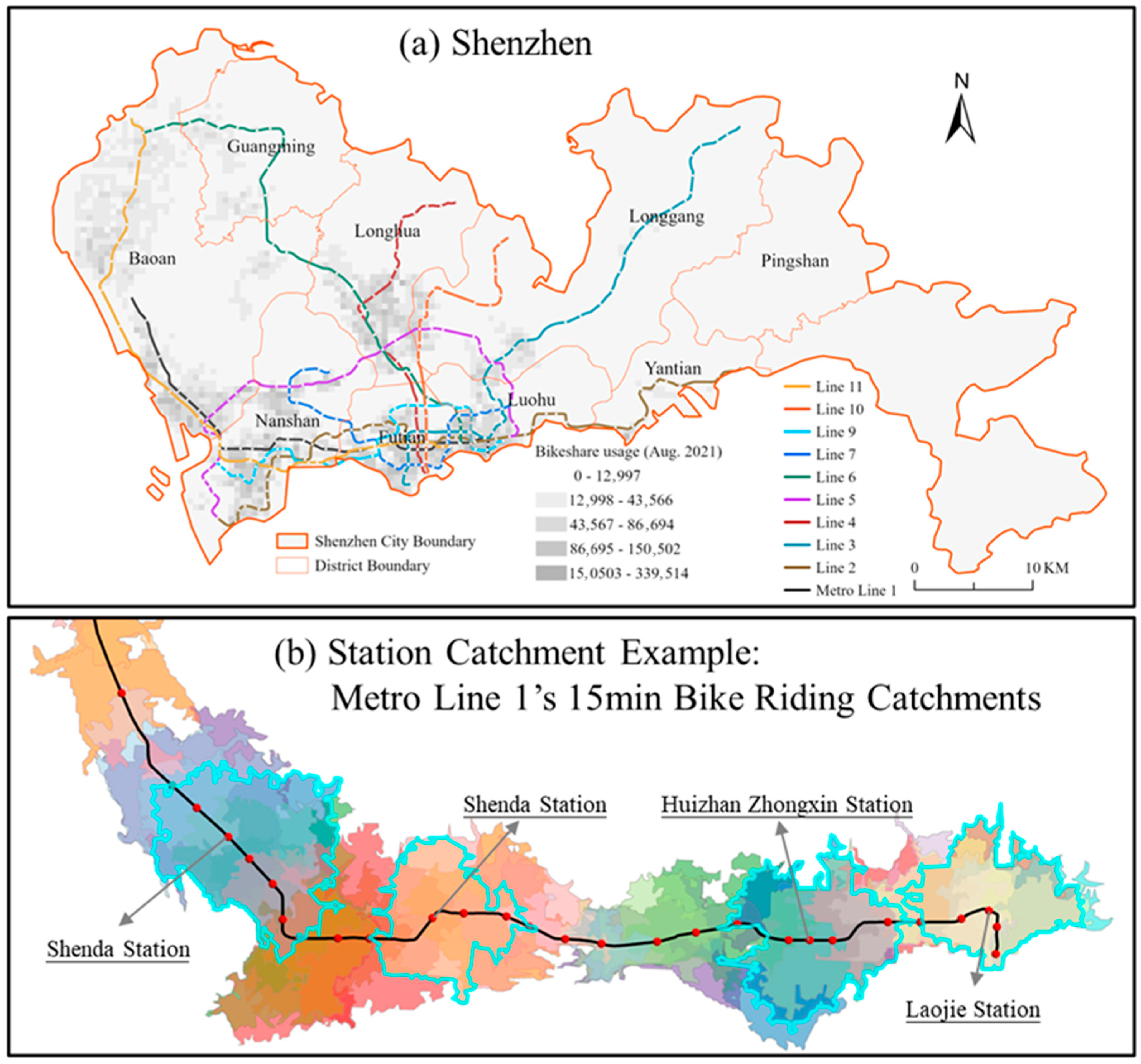
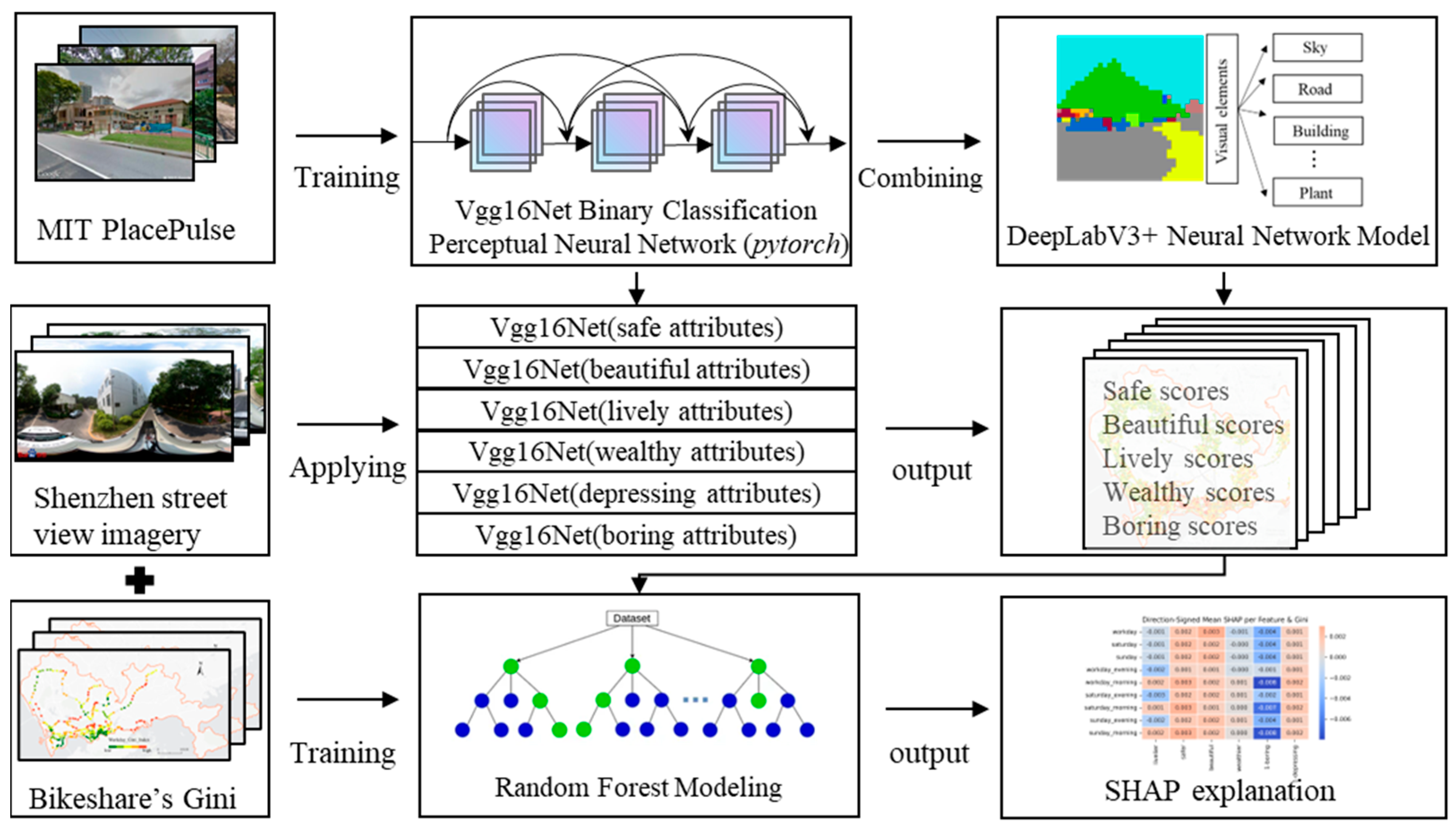

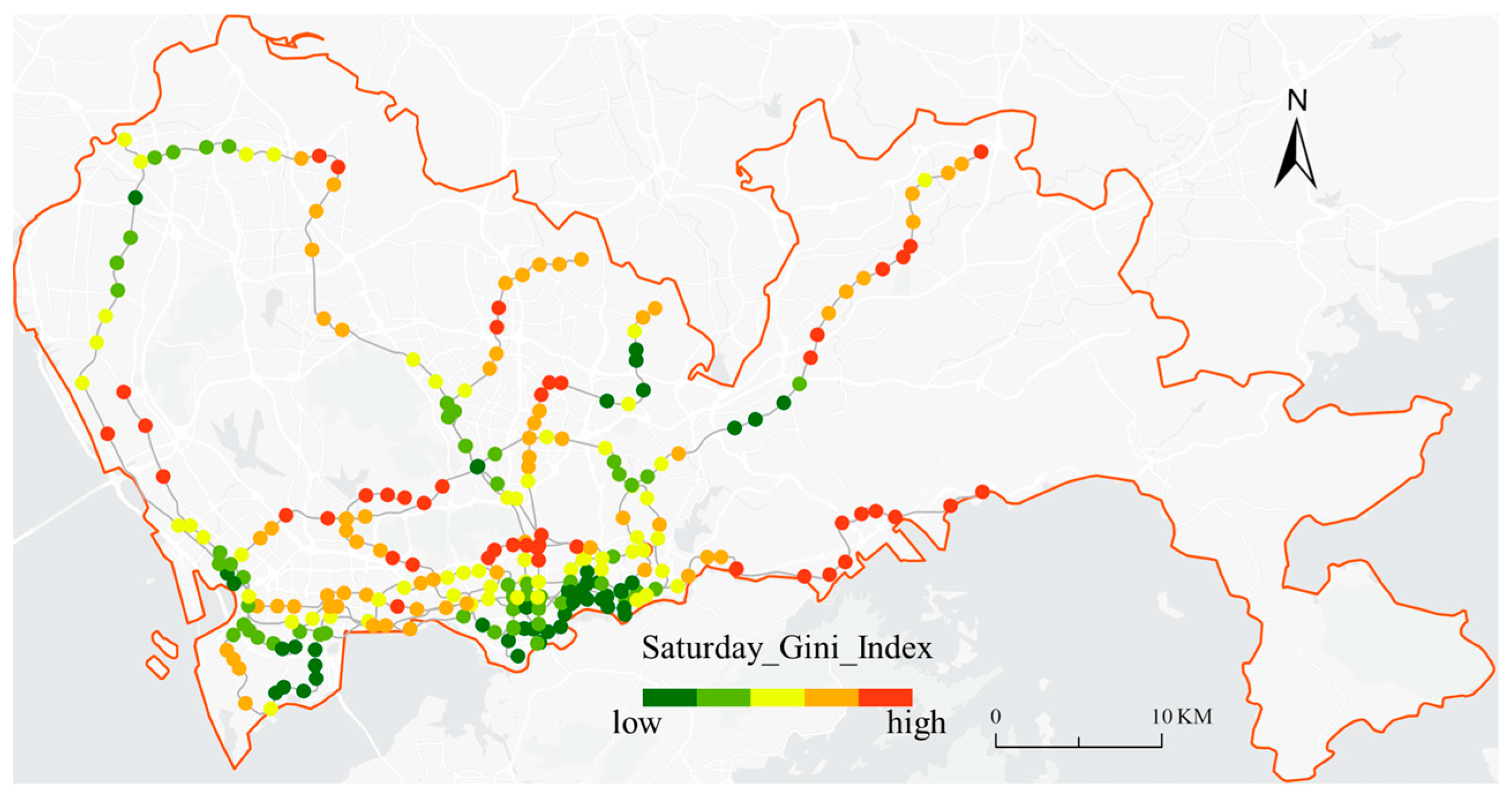
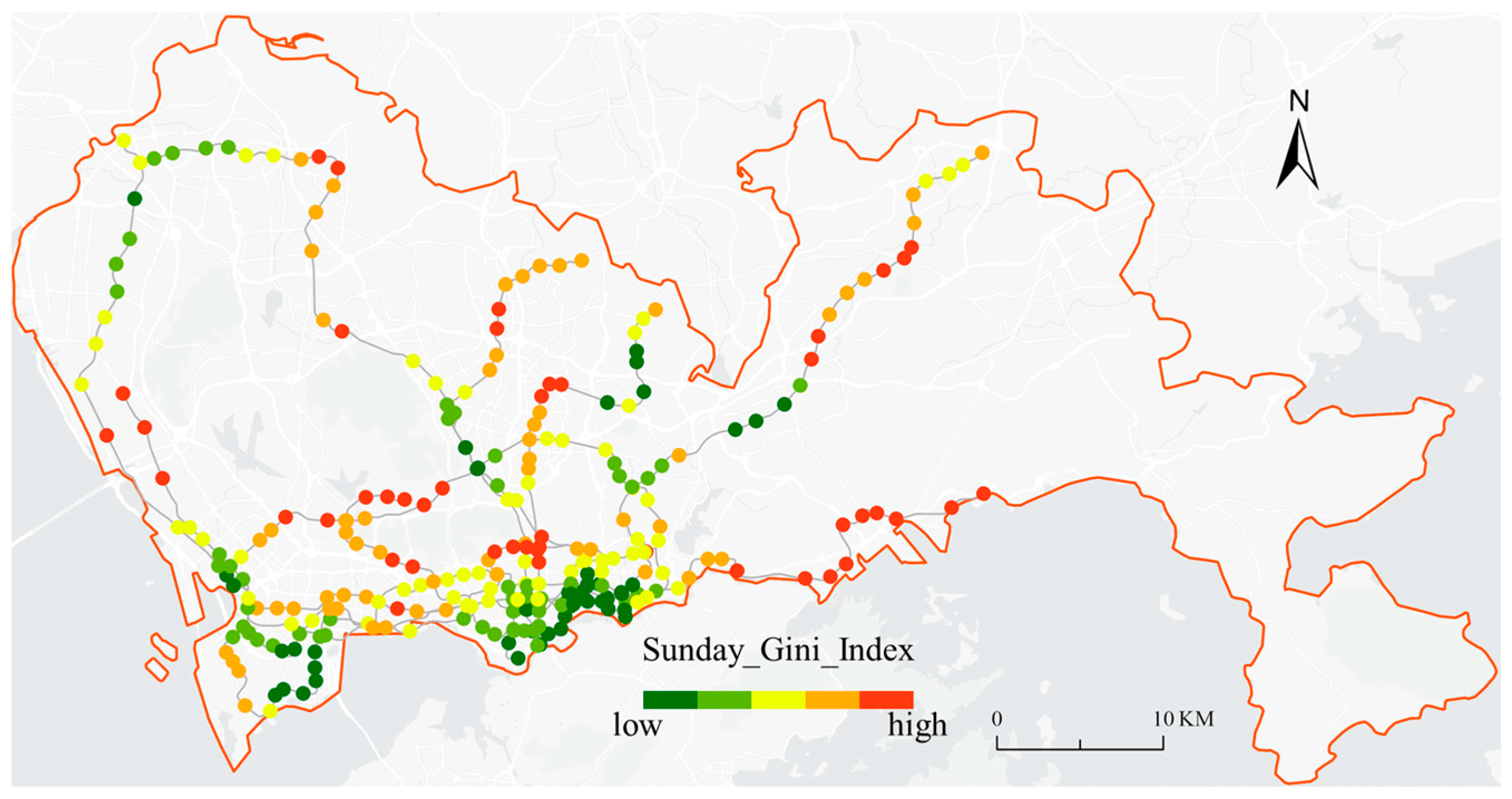
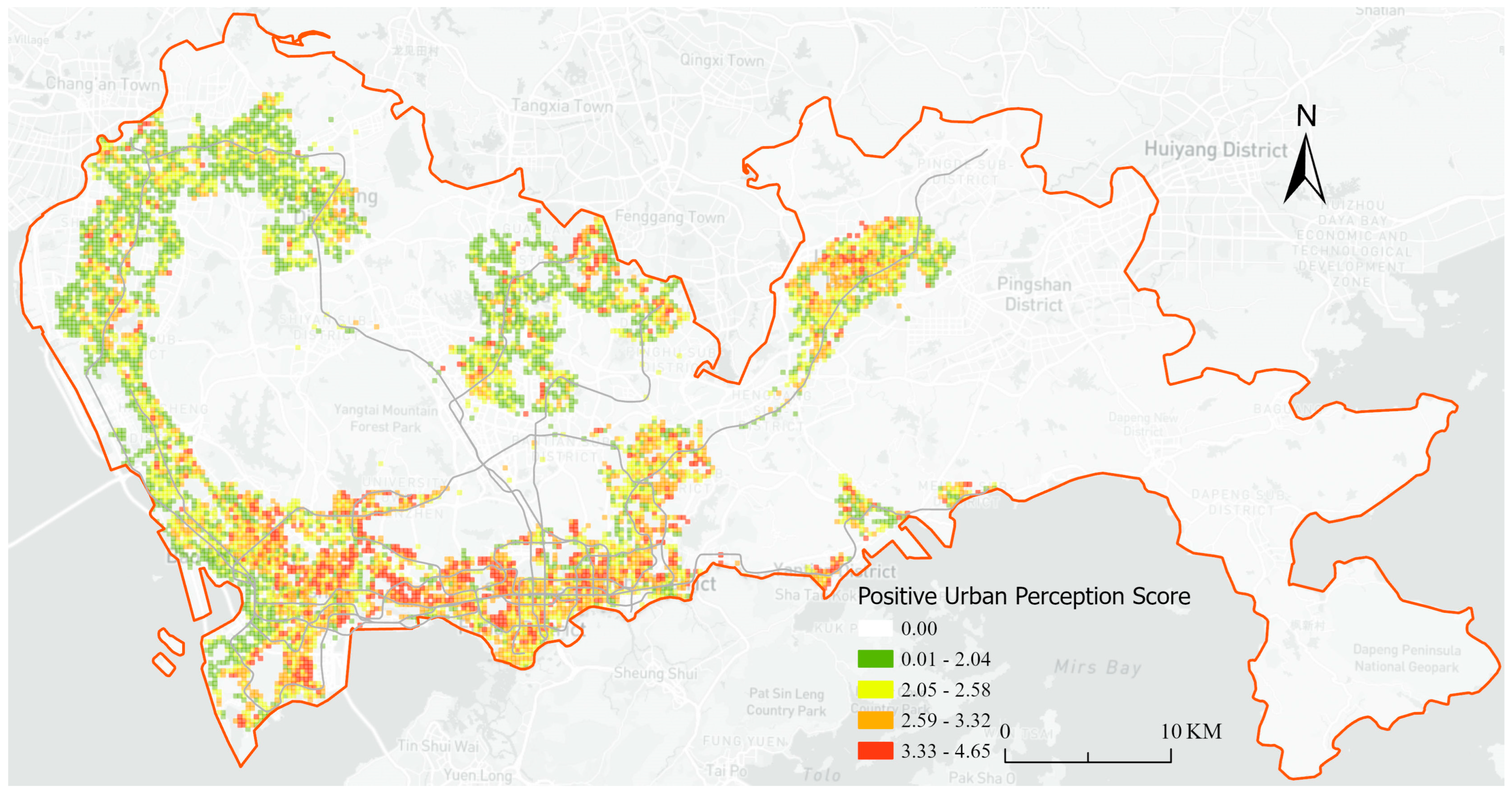
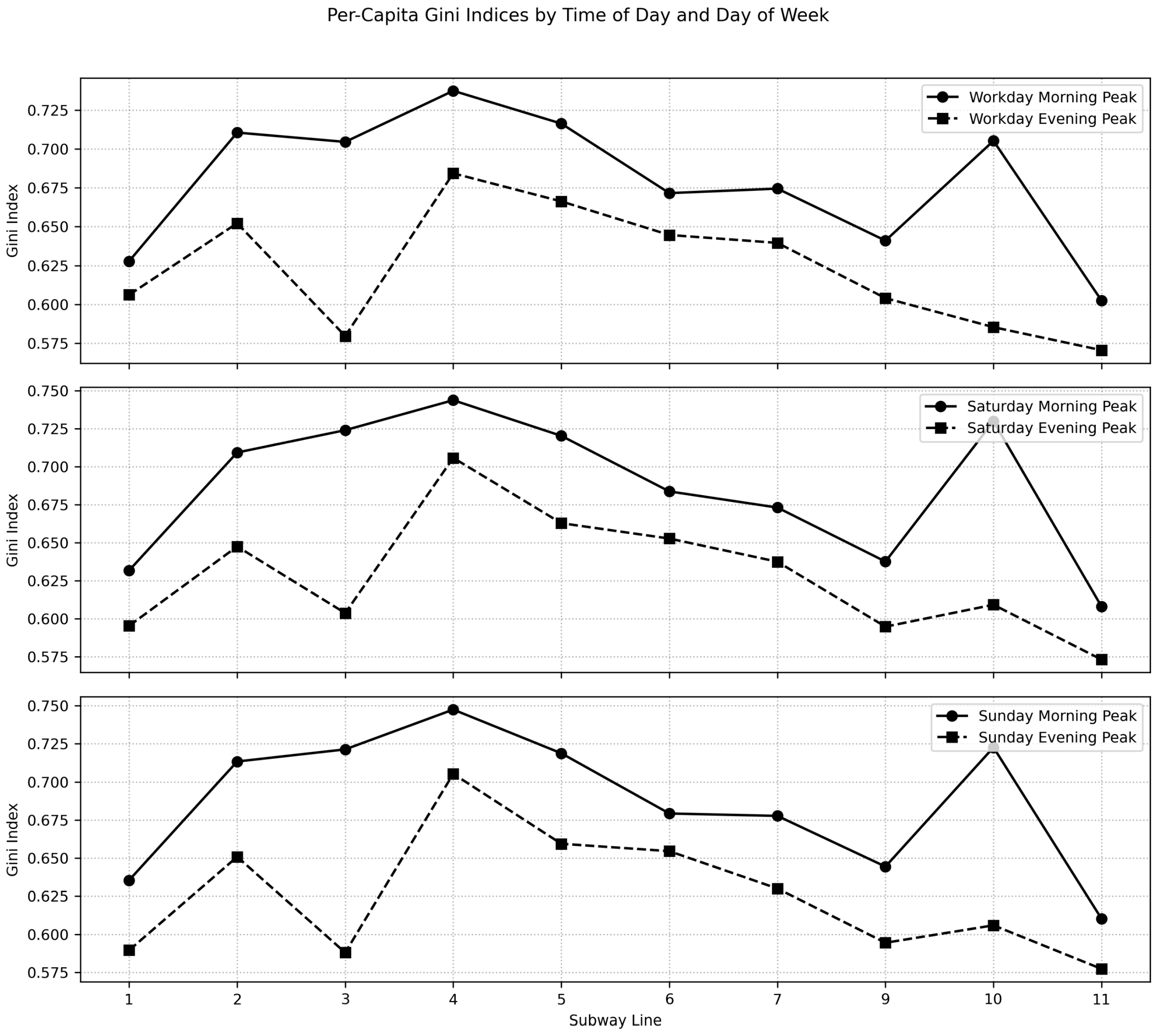
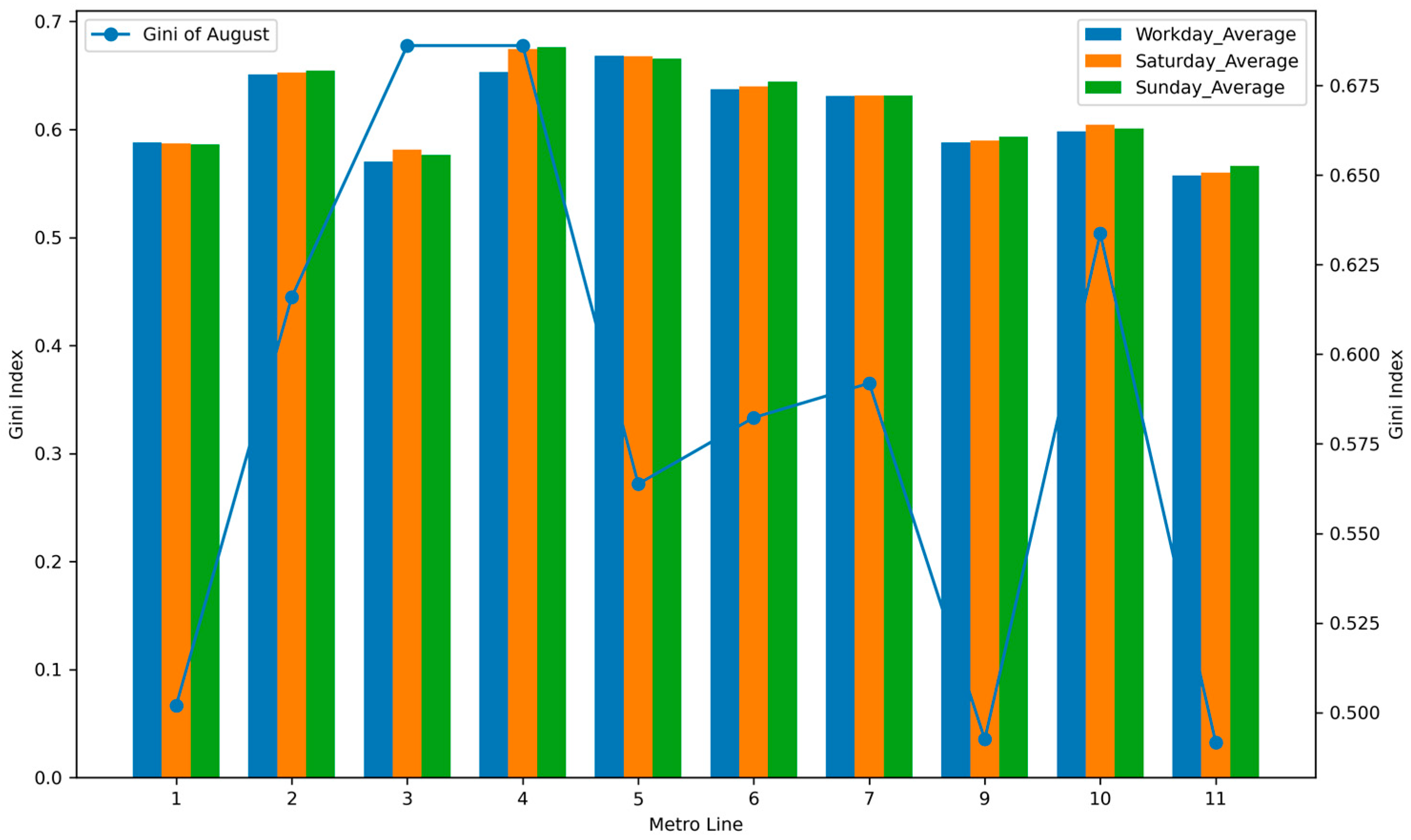
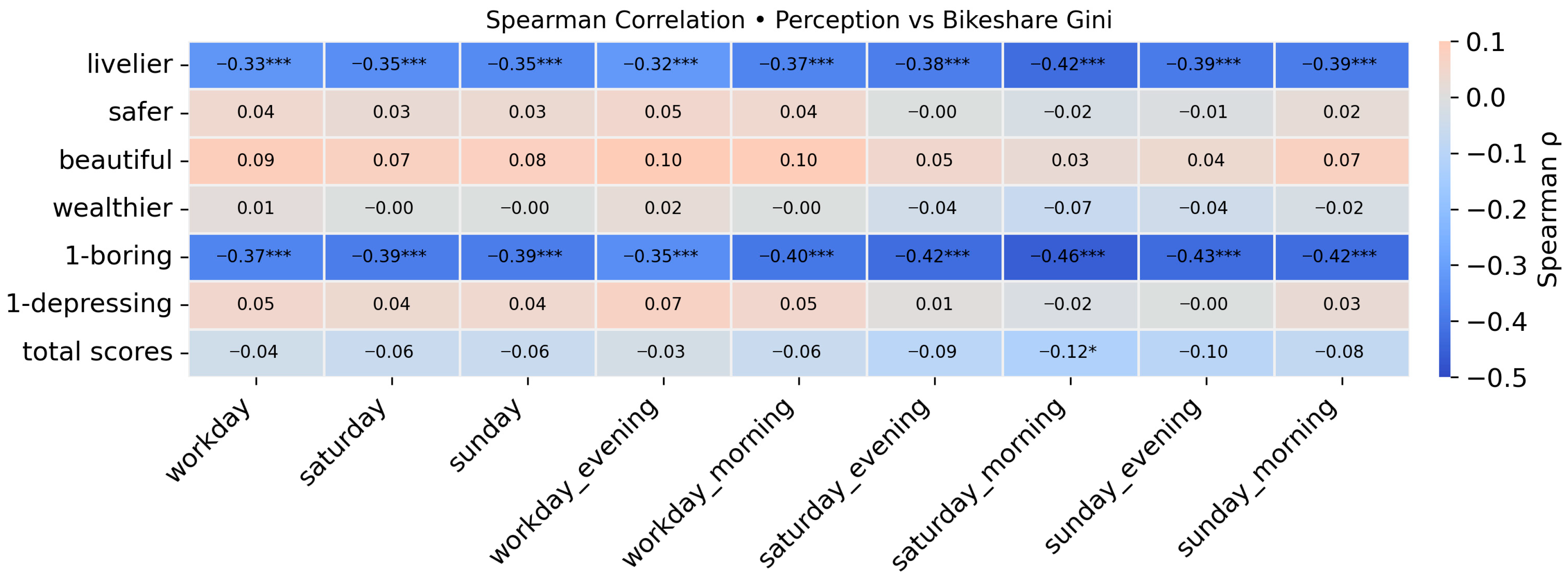
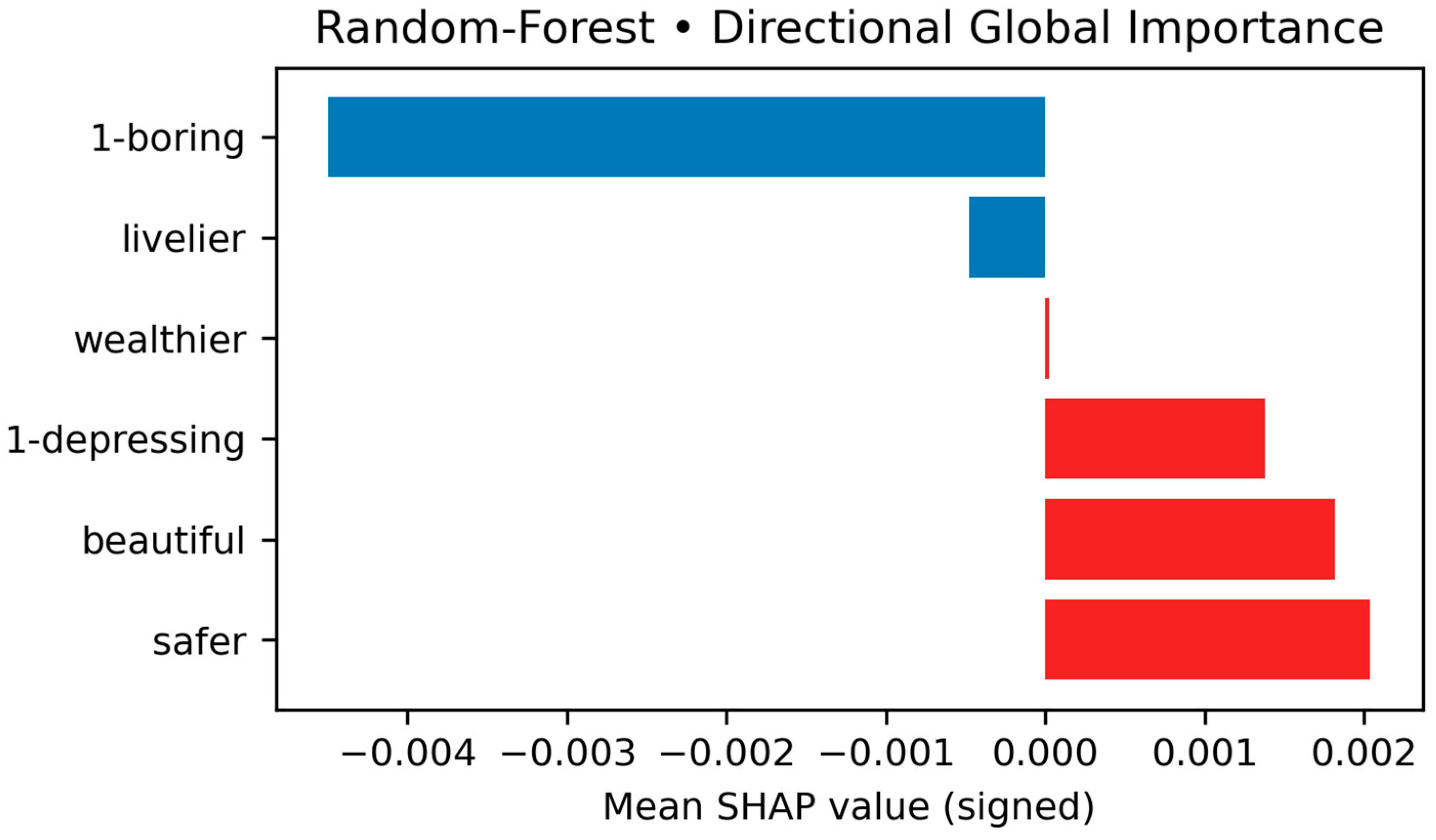

| Parameter | Value | Rationale |
|---|---|---|
| Number of Trees (n_estimators) | 500 | Standard value balancing performance and computational cost. |
| Max Depth (max_depth) | 10 | Tuned via grid search to prevent overfitting. |
| Cross-Validation | 5-fold | Ensures robust evaluation of model performance (and MAE). |
| Overfitting Check | Out-of-Bag (OOB) Score | OOB of 0.42 was very close to the cross-validated, indicating no significant overfitting. |
| Target | MAE | R2 |
|---|---|---|
| workday | 0.063065 | 0.441215 |
| saturday | 0.06437 | 0.435631 |
| sunday | 0.064273 | 0.428886 |
| workday_evening | 0.065257 | 0.346705 |
| workday_morning | 0.064973 | 0.447565 |
| saturday_evening | 0.067026 | 0.398089 |
| saturday_morning | 0.066361 | 0.482398 |
| sunday_evening | 0.066221 | 0.419583 |
| sunday_morning | 0.06525 | 0.462872 |
Disclaimer/Publisher’s Note: The statements, opinions and data contained in all publications are solely those of the individual author(s) and contributor(s) and not of MDPI and/or the editor(s). MDPI and/or the editor(s) disclaim responsibility for any injury to people or property resulting from any ideas, methods, instructions or products referred to in the content. |
© 2025 by the authors. Licensee MDPI, Basel, Switzerland. This article is an open access article distributed under the terms and conditions of the Creative Commons Attribution (CC BY) license (https://creativecommons.org/licenses/by/4.0/).
Share and Cite
Tang, F.; Wang, L.; Zhang, L.; Wang, Y.; Gao, H.; Xu, W.; Shen, Y. The Relationship Between Urban Perceptions and Bike-Sharing Equity in 15-Minute Metro Station Catchments: A Shenzhen Case Study. Buildings 2025, 15, 3874. https://doi.org/10.3390/buildings15213874
Tang F, Wang L, Zhang L, Wang Y, Gao H, Xu W, Shen Y. The Relationship Between Urban Perceptions and Bike-Sharing Equity in 15-Minute Metro Station Catchments: A Shenzhen Case Study. Buildings. 2025; 15(21):3874. https://doi.org/10.3390/buildings15213874
Chicago/Turabian StyleTang, Fengliang, Lei Wang, Longhao Zhang, Yaolong Wang, Hao Gao, Weixing Xu, and Yingning Shen. 2025. "The Relationship Between Urban Perceptions and Bike-Sharing Equity in 15-Minute Metro Station Catchments: A Shenzhen Case Study" Buildings 15, no. 21: 3874. https://doi.org/10.3390/buildings15213874
APA StyleTang, F., Wang, L., Zhang, L., Wang, Y., Gao, H., Xu, W., & Shen, Y. (2025). The Relationship Between Urban Perceptions and Bike-Sharing Equity in 15-Minute Metro Station Catchments: A Shenzhen Case Study. Buildings, 15(21), 3874. https://doi.org/10.3390/buildings15213874








